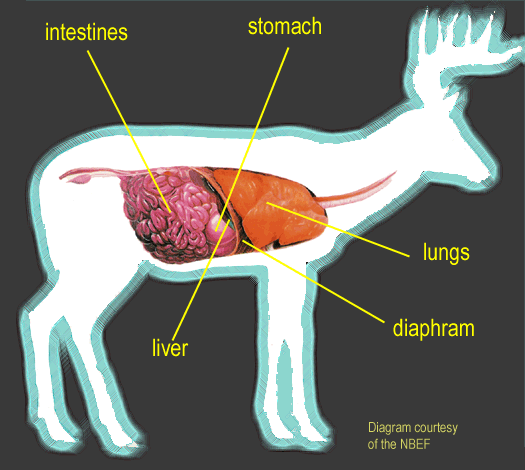After all these years of bowhunting I tend to take it for granted
that bowhunters understand what to do when they Gut Shoot an animal. And
most do know what to do. But on a recent elk hunt I met a guy who
had hit a cow elk a little far back. He showed me the sign, the
arrow, and it was obvious where the animal was hit.
He needed to leave the woods quietly, and return in six hours to
recover the elk. However, he was intent on chasing after it right
away. He was reluctant to listen to advice, but in the end his
friends talked him out of an immediate trail, and the result was good.
Discuss This Article
Years ago my good friend Len Cardinale told me a story of a buck he
shot around mid morning in New York, in the late season. He hit it
back, and immediately a huge snowstorm moved in, bringing 6-8 inches
of snow in a short time. Some bowhunters, after making a paunch
shot, feel that they must track the deer right away if there is
impending snow or rain. This is not what you should do, and Len did
not do so either. From his story I learned a lot.
First, you must recognize a paunch shot. Behavior of the animal upon
the hit is one good sign. Often such animals hunch up at the
shot. Then they walk away slowly with their head down. They often
stop and stand for several minutes. Liver hit animals behave this
way as well. Your job is to remain totally quiet, not revealing
yourself to the animal. If darkness comes and the animal is still
within range and standing, or bedded, you need to sneak out of there
without making a sound.
If it is raining, or if such weather is coming, you still need to get
out of there quietly. To the inexperienced, such advice seems
foolhardy. Rain will wash away the blood trail, so we must follow
the trail right away before we lose it. Right? Not really.
The problem with this logic is that there is no blood trail to
follow. Paunch shot animals don't leave much of a blood
trail. Thus, there is little for the rain to wash away. However,
paunch shot animals, unless disturbed (usually by the bowhunter),
will lay down relatively soon after the shot. In my example above,
Len left this poorly shot buck and drove home, even though snow was
covering the deers tracks. Had he followed right away, he'd have
jumped the buck from it's bed, one hundred yards from the tree stand,
and that buck would have run a half mile before stopping.
With fresh snow he may have been able to follow. But when it rains
and this happens, it's over.
You hear such stories all the time. "I hit him back, and when I
followed an hour later, I jumped him from his bed, and we never found
him." What a waste. Go home, wait 6 hours, and come back as Len
did. Len found that buck 100 yards from his stand, dead. Pope and
Younger too.

Another factor is critical to recovering wounded animals ... knowing
where the animal was hit. I've used yellow and/or white feathers for
50 years and the reason is a simple one. They allow me to better
follow the flight of the arrow and determine where I hit.
On my most recent elk hunt, a big coyote came to water right at
dark. The shot was 29 yards or so, and even in the dim light, I knew
right where my arrow struck that coyote. In that case it didn't
affect the quick recovery. But for deer, elk, moose, etc., knowing
exactly where you hit might determine how and when you follow the animal.
All the above seems fairly basic. Then again, bowhunting is about
basics. I've paunch shot several deer over the years, and I thank
Len Cardinale from New Jersey for his lesson taught those many years
ago. Up till then I figured you had to follow paunched animals right
away if there was rain. Not so. Up till then I figured you need
only wait two hours on a paunched animal. Not so. Six hours is
better (of course if it is very, very hot, and there is a lot of open
country allowing little shade, then you might go a bit earlier to
prevent spoilage ... but usually 6 hours is it).
True, the animals don't always go by the book. But follow these
basic principles and your recovery rate on paunch animals will rise
dramatically. The deer are doing it out there right now, so it's
time to hit the woods.